復興デザインスタジオ2022年夏スタジオ「宇和島湾の日常から考える―巨大地震・豪雨災害への事前復興計画―」は、2022年6月27日に最終発表会をオンラインで実施しました(豊橋技術科学大学と合同実施)。
講評者
水谷 晃啓(豊橋技術科学大学 建築設計)/小野 悠(豊橋技術科学大学 都市計画)/本田 利器(東京大学 防災工学)/福田 大輔(東京大学 交通工学)/羽藤 英二(東京大学 都市交通)/浦田 淳司(東京大学 避難行動)/中尾 俊介(東京大学 都市史)/北原 麻理奈(東京大学 都市計画)/赤松 芳和(宇和島市総務企画部)他
夕陽はそこに(臨海地区)/ Forever Sunset (Waterfront Area)
臨海班:近藤愛子・朴相琥(社会基盤)、太田佳桜・長野歌穂(建築)、永井鷹一郎・平野真帆(都市工)
Waterfront Group :Aiko KONDO, Sangho PARK (Civil Eng), Kao OTA, Kaho NAGANO (Architecture), Yoichiro NAGAI, Maho HIRANO (Urban Eng)
提案概要 / Summary
対象とした宇和島中心市街地西部の臨海地区は,低地が広がる埋立地であり,南海トラフ地震の際には液状化と津波浸水が想定されている.コミュニティ内の交流が少ない上,沿岸部での避難場所確保が課題である.これに対し,沿岸北部にそびえる住吉山の荒廃した避難路と頂上広場と,沿岸部の低地に津波避難ビルとして機能する社員寮の整備を提案する.居心地の良い公園へと生まれ変わる住吉山や,社員寮の開かれたコモンスペースには平時から地域住民が憩う場所となる. また,臨海地区は,災害がなくとも30年後には人口が半減すると予測される一方,港や高速道路のICがあり交通利便性が高く,水産加工業や造船業など海への近接性を活かした第2次産業が盛んな地区である.現在臨海地区の一部は居住誘導区域に指定されているが,災害発生前は徐々に居住誘導区域を後退させ内陸側に緩やかに人口を誘導し,災害発生後には災害危険区域に指定する.その上で立地のポテンシャルを活かして,産業のまちへと転換させていく.
The waterfront area of central Uwajima is reclaimed land and thus low-lying; the area is at great risk of liquefaction and tsunami inundation when the Nankai megathrust earthquake hits. There is little communication within the community and effective evacuation spots are lacking by the shore. To solve these issues, we propose to (i) establish safe evacuation routes to the now wasted Mt. Sumiyoshi and (ii) build a company dorm that functions as a tsunami evacuation building. Local residents will be able to gather and recreate at the comfortable park Mt. Sumiyoshi has turned into, or at the common space in the dorm which is open to everyone. The population of the waterfront is expected to half in 30 years, but it is conveniently located with a port and a highway IC. The proximity to the sea supports secondary sectors such as fish processing and ship building to thrive in the area. Though part of the waterfront area is currently designated as a residence attraction zone, we propose to back off the designation inland before a disaster occurs. After a disaster, the area will be designated as a disaster risk zone. Utilizing the high potentials, this area will attract more industries and in future years, transform into an industrial area.
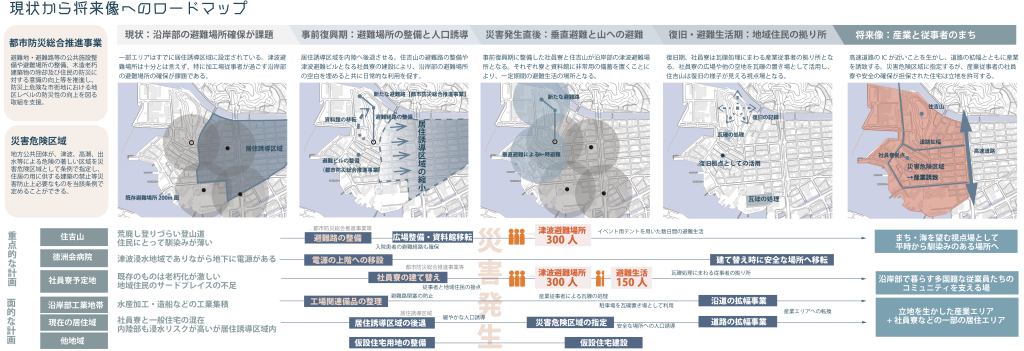

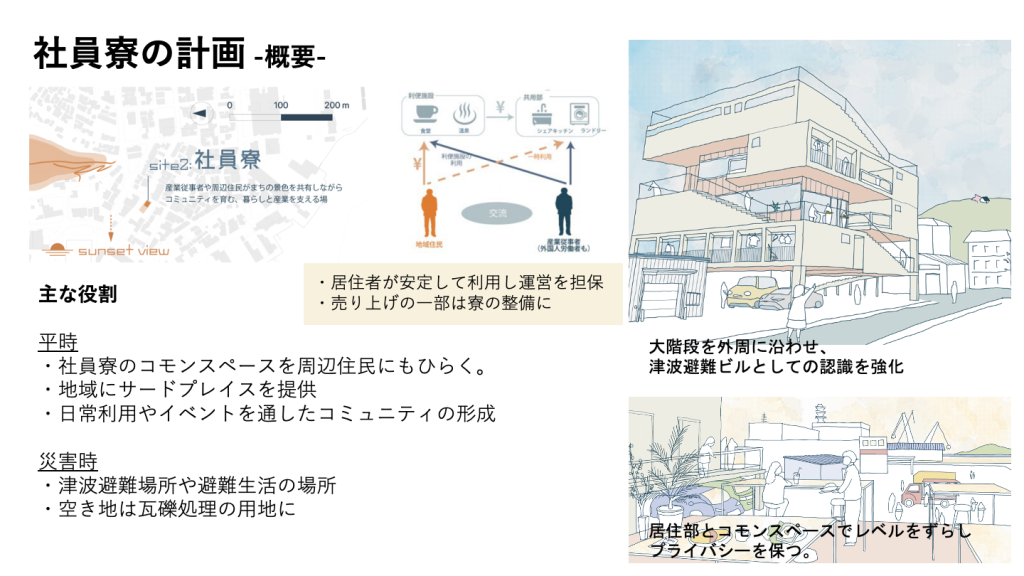
浦田淳司 地域と産業の分断という課題に対しても,社員寮内にコミュニティスペースをつくるという提案は,ひとつの解決策だと思います.一方で,外国人の問題はどうでしょうか.社員寮は建て替えをするかと思いますが,現在の寮居住者の一時移転などもあります.そのタイミングも,きっかけとして使えるといいのかなと思いました.
J.Urata Making a community space inside the dorm seems like an answer to the division between the local community and the industry. On the other hand, how about the issue of foreigners? The dorm will undergo reconstruction, and the current residents of the dorm will be temporarily relocated. I thought it would be good if you could utilize the timing as a trigger
羽藤英二 事前復興としては,将来の土地利用の考え方が整理されており,説得力がある提案を含んでいると感じます.現在の住吉山の散策路は荒廃していて,住吉山が活かせる地域資源と見做されていないのが,大きな問題となっていると思います.どのようにして地域の意識に働きかけていくかを考えることも必要でしょう.
E. Hato As a pre-disaster redesign plan, the concepts of future land use is well organized and you included convincing proposals. The current walking trail of Mt. Sumiyoshi is wasted, and the mountain isn’t regarded as a local resource. I think this is the great problem. It is important to think about how to reach out to the consciousness of the community.
中尾俊介 社員寮の方は建築的に複雑で,コンセプトと合致していて良いですね.災害時に居住者がどういう暮らしをするのかも考えられていて良かったです.低地から住吉山~病院,社員寮といいった動線を設定したことにより地域の暮らしがどう変わっていくのか,その後の効果・変化の部分が気になりました.
S. Nakao The dorm is architecturally complex, and it is good that it is consistent with the concept. It is also good that you considered the lifestyles of the residents in an event of a disaster. I am interested in the effects and changes of the lives of the community after your proposed flow: from the low-land, to the hospital, to the dormitory.
遊子を継ぐ 〜天と地と海のはざまで生きる〜/Succeed Yusu ~below heaven, on earth and beside sea~
遊子班:西山椋太・福谷きり(社会基盤),俵健太郎・山本実南(建築),高野楓己・宮園侑門(都市工)
Yusu Group:Ryota NISHIYAMA, Kiri FUKUTANI (Civil Eng), Kentaro TAWARA, Minami YAMAMOTO (Architecture), Funa TAKANO, Yuto MIYAZONO (Urban Eng)
提案概要 / Summary
遊子地区は三浦半島に位置しする漁村集落.全体として真珠・ハマチ・タイが名産だが,浦ごとに多様な漁業が,遊子に住む親世代と宇和島市街地から通う子供世代により営まれる.漁業が盛んになる前は段畑が山一面を覆っていたが,今や面的な段畑は水荷浦に見られるのみ.災害時には,一時的に逃げられても浦や半島が孤立した時に3日〜1週間生き残るための空間・準備の不足,宇和島市街地の仮設や家族の元などにバラバラに避難しコミュニティ崩壊,東日本大震災の復興手法(防潮堤建設/嵩上げ/高台移転)による遊子に固有な生活・生業・景観の喪失,それ以前に,同等の投資を行うのは時間・経済・人的に不可能,という課題がある.平時の課題としては少子高齢化による疎化,遊子の資源を生かしきれていないということが挙げられる. 以上を踏まえ「遊子に住めなくなる」という最悪の事態を回避すべく,漁業の中心=魚泊,コミュニティの中心=番匠・甘崎,観光の中心=水荷浦の4浦を「居住浦」とし,居住を集約していく仕組みを挿入,他の浦を「漁業浦」とし,遊子に根付く他浦からの通い漁業により,多様な漁業を守る.
The Yusu district is a fishing village located on the Miura Peninsula. The fishing industry is famous for pearls, yellowtails, and sea breams, and the catch of fish is different Uras (villages) to Uras, which is managed by the parents living in Yusu and their children commuting from Uwajima city area. Before the fishing industry flourished, terraced fields covered the entire mountain, but now they can be seen only in Mizuga-Ura. In the event of a disaster, space and preparation for surviving three days to a week will be lacking, when the Uras and the peninsula are isolated, even if people can escape temporarily. In addition, the community collapses as people evacuate to temporary shelters or their families in Uwajima city area, and life, livelihood, and landscape unique to Yusu will be lost due to the reconstruction methods of the Great East Japan Earthquake (construction of sea walls, raising of buildings, relocation to higher ground). The challenges in normal times are the aging and shrinking population and the lack of utilization of Yusu’s resources. In order to avoid the worst-case scenario of “no longer being able to live in Yusu,” a mechanism to consolidate residency is inserted by designating four Uras as “Residential Uras,” namely, Uodomari (the center of fishing), Bansho and Amazaki (the center of community), and Mizuhari (the center of tourism), while other Uras are designated as “Fishing Uras,” where various types of fishing are protected through commuting from other Uras.



小野悠 遊子の中にいくつか浦があって,そのうちの中心的な場所である魚泊を対象地に選んで設計されたということだが,この設計はほかの浦でも同様に適用可能か?また,より小さな浦に対してサポートするような機能が提案に含まれているのか?
H.Ono I understand that there are a number of ura in Yusu and that Uodomari, the central ura among them, was selected as the target site for the design. Is this design applicable to other ura as well, and are there any features in the proposal that would support smaller ura?
水谷晃啓 低地に住み続けられる提案をしていて,既存の住宅の作り方はどうなっていた?一気に建て替えるのは現実的でないので、設計のプロセスとして、ここから建て替えていくべきだ、などの提案があるとなお良い。地形とも関係していそうなので、そのあたりも調べられると。
A.Mizutani You are proposing to continue to live in the lowlands, how were the existing houses built? It is not realistic to rebuild all at once, so it would be better to have suggestions as part of the design process, such as, we should rebuild from here. It would also be good if the topography of the area could be investigated as well.
福田大輔 現状の人口分布の重心で考えると,魚泊よりも南の蕃匠や甘崎の方もありうるのかなと思いましたが(小学校もありますし),そういった点は議論されましたでしょうか? また,鰤の養殖と真珠の養殖の境界みたいなことも考える必要があるのかなと思いましたがそれはいかがでしょうか?
D. Fukuda Considering the current center of gravity of the population distribution, I was wondering if the site could be Bansho and Amazaki, located in the south of Uodomari, (there is also an elementary school) have such points been discussed? I also wondered if we need to consider something like the boundary between amberjack farming and pearl farming, but what about that?
赤松芳和 あのとき、地元の方とのふれあいを通じて伝えられた遊子の皆さんの思いを形にしていただいた提案になっていますね。感動しました。
Y.Akamatsu Your proposal has given form to the thoughts of the people of Yusu that were conveyed to us through our interaction with the local people at that time. I was very impressed.
海城を顧みる / Reconsider the Sea Castle
城下町班:奥田勇・助川皓洸・Chee Yung LO(社会基盤),伊室武・露木百音(建築),橘俊輔・森屋友佑(都市工)
Joukamachi Group:Isamu OKUTA, Hirotake SUKEGAWA, Chee Yung LO(Civil Eng), Takeru IMURO, Mone TSUYUKI(Architecture), Shunsuke TACHIBANA, Yusuke MORIYA(urban Eng)
提案概要 / Summary
宇和島の中心市街地である城下町地区は,他の地方都市と同様に,人口減少,高齢化,商店街の衰退といった問題を抱えている.空地や空き家の発生もみられ,特に非浸水域である南東部エリアの人口減少率が高い.そういった平時の課題と,災害時に起こるであろう問題に対して,住民の方々の誇りである「宇和島城」をはじめとする歴史的資源を活用しながらアプローチする事前復興プランを提案した. 南東以外の「浸水域」については,空地の暫定利用を行い,空地の空いた状態を安定させ,建築を防ぎつつ,災害時にはその空地を物資供給や滞在場所として活用する.南東の「安全域」については,行政が長期的に空地を集約化するようにコントロールし,元々少ない広場空間の創出や,道路空間の再編による魅力や利便性の向上で居住誘導を図る.発災時の一時避難場所や避難ルートの充実,復興期の住宅再建円滑化の狙いもある.複数選択した敷地が持つ歴史的なつながりは海との距離の直観的な理解を助け,さらに空地の集約化と同時並行で行われる道路空間の再配分による「ウォーキングコースの整備」や「公共交通網の再編」によって城下町地区全体のネットワークが構築される.
Like other rural cities, the castle town area of Uwajima’s central district faces the same problems of population decline, aging population, and decline of the shopping district. Vacant lots and vacant houses are also seen, and the population decline rate is particularly high in the southeast area, which is not flooded. To address these issues in normal times and the problems that are likely to occur in the event of a disaster, we proposed an advance recovery plan that approaches these issues by utilizing historical resources, such as Uwajima Castle, which is the pride of the local residents. For the “flooded areas” outside of the southeast, we propose the temporary use of vacant land to stabilize vacant land, prevent construction, and use the vacant land for supplies and places to stay in the event of a disaster. For the “safe zone” in the southeast, the government will control the consolidation of vacant land in the long term, and will create open space, which was originally scarce, and reorganize road space to make it more attractive and convenient for people to live there. It also aims to enhance temporary evacuation sites and evacuation routes in the event of a disaster, and to facilitate housing reconstruction during the recovery period. The historical connection between the multiple sites selected will help the residents to intuitively understand the distance to the sea, and the reallocation of road space, which will be carried out concurrently with the consolidation of vacant land, will create a network of the entire castle town area through the “development of walking trails” and “reorganization of public transportation network”.

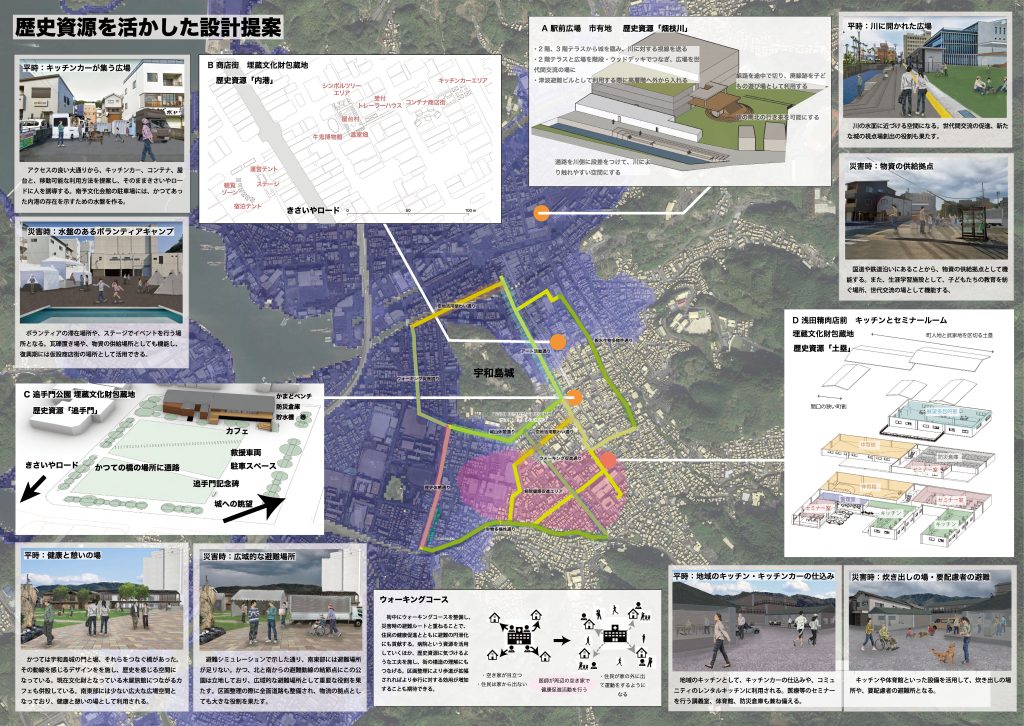
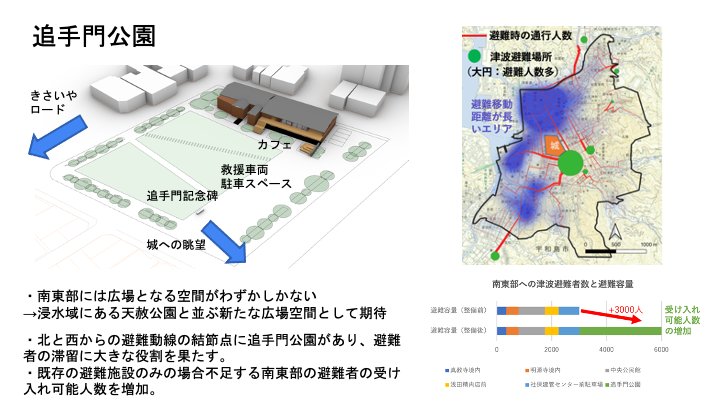
赤松芳和 現地調査を踏まえた柔軟な提案となっており,感心しました.
Y.Akamatsu I was impressed by the flexibility of the proposal based on the field survey.
水谷晃啓 建築提案としては全体性がないように見えましたが,ウォーキングの話で全体をつなげているのはよかったです.ウォーキングの話では,建築をどこまで作りこもうとしているのでしょうか?また,建築を造らない提案でどこまで足りると考えていますか?経験的なことを日常から浸透させていこうということは良いと思います.建築の方もそれと絡めて作っていくと良いと思ったのと,建築をあえて強くつくる必要もない気がしておもしろく感じました.
A.Mizutani As an architectural proposal, it didn’t seem to have a whole, but it was good that you connected the whole with the walking story. How far are you trying to go with the walking story to create architecture? And to what extent do you think that the proposal without architecture is sufficient? I think it is good that you are trying to instill experiential things into everyday life. I thought it would be good if the architecture was also intertwined with it, and I felt that there was no need to make the architecture stronger, which I found interesting.
羽藤英二 スポンジ化は海外でもみられる現象ですが,事前復興によって災害の間に現象の進展を抑制することができるというのはいい案ですね.空地や,相続,商売の継承のメカニズムについては,詳しく問題設定できると市民の側に求められている対応がよりわかりやすいのではないでしょうか.
E.Hato Spongification is a phenomenon that can be seen in other countries as well, and it is a good idea to be able to control the development of the phenomenon during a disaster through advance reconstruction. It would be easier to understand the response required on the part of citizens if we could set up detailed problems regarding vacant land, inheritance, and the mechanism of business succession.
北原麻理奈 スポンジ化というマイナスに思われることを,プラスに転換できそうな提案はよかったです.全体の提案と日常的な変化の部分の繋がりがもう少し明確に表れていると良かったです.」
M.Kitahara I liked the proposal to turn what might be considered a negative aspect of sponging into a positive one. I would have liked to see a clearer connection between the overall proposal and the daily changes.”
衛星村 / Satellite Villages
大浦班:橋本千宙・増橋佳菜(社会基盤)、久津輪渓・國井奏(建築)、長谷川帆奈・ Qiu Rui(都市工)
Oura Group :Chihiro HASHIMOTO, Kana MASUHASHI (Civil Eng), Kei KUTSUWA, So KUNII (Architecture), Hana HASEGAWA, Qiu Rui (Urban Eng)
提案概要 / Summary
大浦地区は、宇和島市街地・吉田・三間の3つの拠点に対してハブとなりうる好立地であり、各拠点同士の代替性の低い交通網を強化する重要なポテンシャルを秘めている。その反面南海トラフ地震に伴う津波浸水や豪雨時の土砂災害リスクを抱え、少子高齢化に伴なって域内の避難施設も荒廃しつつある。 そこで、宇和島市内の公共交通網計画の再編成のもと、大浦を新たなハブとして位置付けるべくバスタ事業を実施し、居住地域としての立ち位置を確立させるとともに市内の交通網の代替性を高める。同時に、津波避難シミュレーションに基づいて配置した「統括避難所」「拠点避難所」「応急避難所」なる階層的な避難所整備を行う。統括避難所は前述のバスタであり、行政が主体となりバスタ事業を進めると同時に残土は域内の災害公営住宅等の用地造成を進める。対して拠点避難所以下は、本地区特有の熱心な自主防災組織活動の延長として整備を進めることでセルフビルドの防災まちづくりの一環として整備する。急峻な坂の多い域内のモビリティには初期投資・維持管理費の低いバギーを採用し、平時・災害時の高齢者の足となっていく。
The Oura area is well located to serve as a hub for the three hubs of Uwajima City, Yoshida, Mima and city center, and has the potential to strengthen the transportation network with low substitutability between each hub. On the other hand, the area is at great risk of liquefaction and tsunami inundation when the Nankai megathrust earthquake hits and landslide disasters during heavy rains. Moreover, evacuation facilities in the area are falling into disrepair due to the declining birthrate and aging population. Therefore, under the reorganization of the public transportation network plan in Uwajima City, a bus terminal project will be implemented to position Oura as a new hub, to establish its position as a residential area and to improve the substitutability of the transportation network in the city. At the same time, a hierarchical system of evacuation centers will be established based on tsunami evacuation simulations, consisting of a “general evacuation center,” a “base evacuation center,” and an “emergency evacuation center. The main evacuation center means the bus terminal as mentioned, and the government will take the lead in promoting the bus terminal project. While the same time, the remaining soil will be used to develop land for disaster public housing and other facilities in the area. On the other hand, the base shelter and below will be developed as part of the self-built disaster prevention town planning, as an extension of the enthusiastic activities of the voluntary disaster prevention organization unique to this area. ATVs, which have low initial investment and maintenance costs, will be adopted for local mobility in the area, which has many steep slopes, and will provide transportation for the elderly both during normal times and in times of disaster.
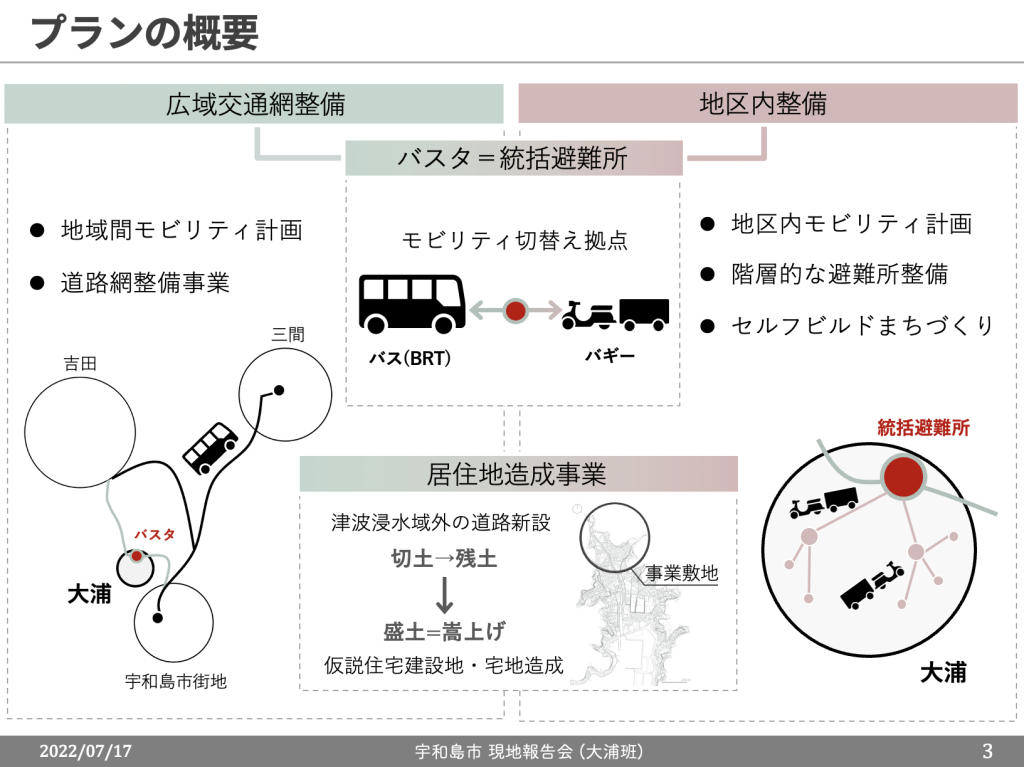
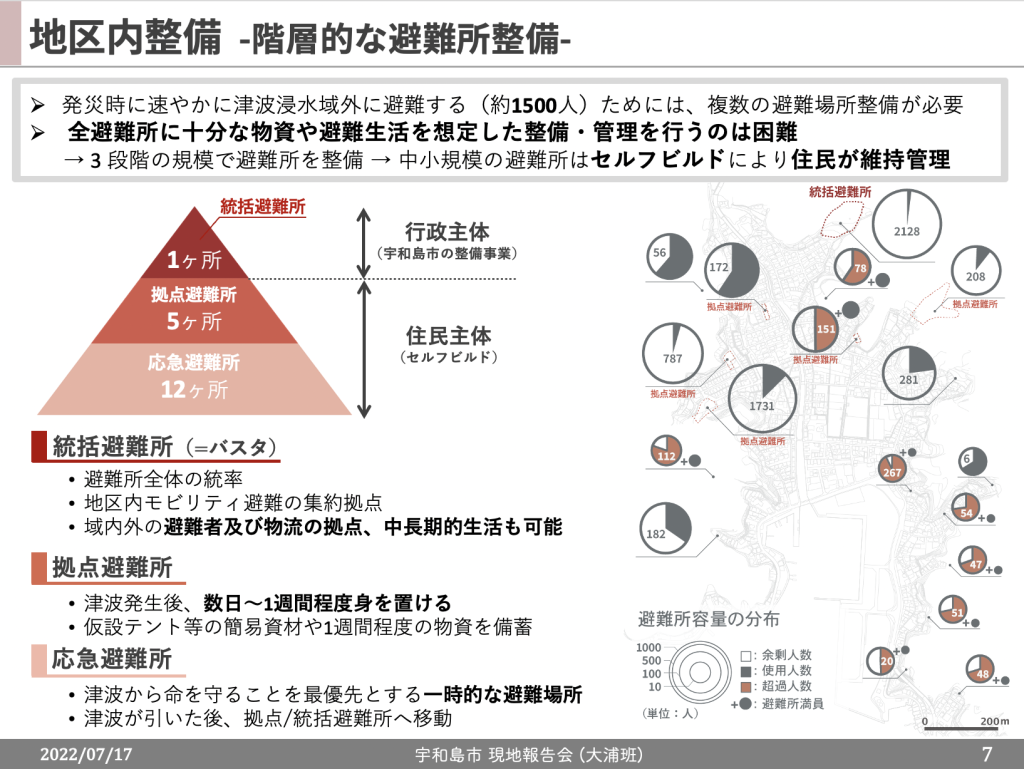

水谷晃啓 すごく面白い提案でした。木材チップで避難経路を作ったり、木材でバギーの停留所を作ったりというのは、林業の作業道路と関連しているのですか。だとすると木材を運搬する道も必要になりますね。それと避難経路が関係してくるともっと面白くなりそうです。
A.Mizutani That was a very interesting proposal. Are the evacuation routes made of wood chips and the buggy stops made of wood related to forestry work roads? If so, then we would also need a road to transport the wood. It will be more interesting if the evacuation route is related to that.
羽藤英二 海側に避難タワーを配置することで、山側の統括避難所の存在感が減ってしまわないですか。重心が海側に降りてしまう気がします。すぐ背後に高台があるので、海側に施設はない方が計画意図が明瞭になると思います。
E.Hato By placing the evacuation towers on the sea side, won’t the presence of the general evacuation center on the mountain side be reduced? I feel that the center of gravity will be shifted to the sea side. There is a plateau right behind it, so I think it would make the intent of the plan clearer if there were no facilities on the sea side.
浦田淳司 避難所の名称をオリジナルでつけているが、現行の制度と対応する名前は何になりますか。全国統一では『一時避難所』という名称が既存であるので、混乱を招くのではないかと懸念します。実際の日本の仕組みとの整合なども、地元に提案する際には考慮した方が良いと思います。
J.Urata You have given an original name to the shelter, but what is the name that corresponds to the current system? I am concerned that the existing name ‘temporary shelters’ in the national unification may cause confusion. I think that consistency with the actual Japanese system, etc., should be taken into consideration when proposing this to the local community.
柔軟に住まう ~生きる活力と宇和島への想いに寄り添う事前復興マスタープラン/Be Flexible ~Pre-disaster Redesign Master Plan to Support Hope and Vitality~
マスタープラン班:Kasun Thalgaskotuwa・加藤諒・長谷川啓太(社会基盤)、崔帥玲・山澤卓也(都市工)、高見澤 勇太・富所貴大(建築)
Master Plan Group:Kasun Thalgaskotuwa ・Ryo Kato・Keita Hasegawa (Civil Eng)、Shuailing Cui・Takuya Yamazawa (Urban Eng)、Yuta Takamizawa・Takahiro Tomidokoro (Architecture)
提案概要 / Summary
個別敷地の事前復興プランがそれぞれ秀逸であっても、「まち」全体の営みの継続がなければ持続的ではない。人口減少時代の被災の最大のリスクは、被災を契機とした人口の流出による「まち」の営みの喪失ではないか。人命を守る≠生活を守る。津波の被害を受けない微高地がわずかしかない宇和島市街では仮設住宅用地の不足が懸念される。被災後1ヶ月~数年間の仮設住宅期における生活の継続に最大の課題があると考え、ここを重視した俯瞰的な「事前復興マスタープラン」を提案する。 近隣に用地がなく仮設住宅が元の住宅や職場から遠いとき、その間の移動手段がなければ生活は維持できない。そこで中心市街から北東10kmほどの田園地帯である三間地区に大規模な仮設住宅を設けることで、利便性の高い公共交通により中心市街と仮設住宅を結ぶ。仮設住宅が一か所にまとまることで、公共交通の運行頻度の向上が見込まれるだけでなく、生活再建を支援するための福祉サービスの提供もしやすくなる。また、平時から津波に安全な微高地への居住誘導を実現するため病院をコアとした歩行空間整備を提案している。被災後も宇和島が「まち」として機能し続けることで、市民の生活再建を支えるだけでなく西南四国の復興の要としての役割も期待できる。
Even if the pre-disaster redesign plans for individual sites are well elaborated, they are not sustainable without the continuity of the city: interaction of people as a community. We discussed that the greatest risk of a catastrophic disaster in the trend of declining population is the loss of such continuity due to the sudden outflow of population triggered by the disaster: some pre-disaster redesign plans may save lives but not their living. In Uwajima City, where there is only a small amount of elevated land, the issue is that the possible site for temporary housing may not be enough after a large tsunami. We considered that the biggest issue is the continuity of living during the period of temporary housing (1 month ~ several years after the disaster), and therefore we propose “Pre-disaster Redesign Master Plan” that focuses on this issue from a comprehensive view. Since there are few possible sites for temporary housing near downtown Uwajima, tsunami victims may have to be accommodated in the temporary housing far away from the original residences or workplaces. Their living cannot be maintained without any transportation between the temporary housing and the original residences. Therefore, a large-scale temporary housing facility will be built in the Mima area, a rural area about 10 km northeast of downtown Uwajima, to connect to downtown Uwajima by highly convenient mass public transportation. The clustering of temporary housing in one location will not only improve the frequency of public transportation services, but will also facilitate the provision of welfare services to help people rebuild their living. In addition, we propose the development of pedestrian-friendly roads with a hospital as its core in the elevated area in order to guide residential areas to safe areas from tsunami. By supporting the continuity of the living of the residents in Uwajima after a catastrophic disaster, Uwajima can be expected not only to support its citizens, but also to play a key role in the reconstruction of southwestern Shikoku.



羽藤英二 高知と愛媛の間の地域は具体的に復興計画を考えていかないといけないにもかかわらず,県境ゆえに今までちゃんと考えられていなかった.宇和島市内のマスタープランを越えて、四国の西南地域全体を考えていくという視点は非常によかった。
E. Hato Even though southwest Shikoku needs a specific recovery plan, it has not been properly considered until now because of the prefectural border between Kochi and Ehime. Your perspective of going beyond the master plan for Uwajima City and considering the entire southwest Shikoku was very good.
中尾俊介 今後、もう一歩、たとえば三間において、復興期の住宅地形成がどのように既存市街地と共存していくのか。風致地区という話も出たが、三間の既存の農業景観との兼ね合いまで含め、将来の三間の姿を描ける提案になると良いでしょう。
S. Nakao I would like you to take one more step. For example, in Mima, how will the formation of residential areas during the reconstruction period coexist with the existing communities? The idea of a “scenic area” was mentioned in Q&A. It would be great if the proposal could depict the future of Mima, including how the existing agricultural landscape of Mima will be combined with your residential plan.
